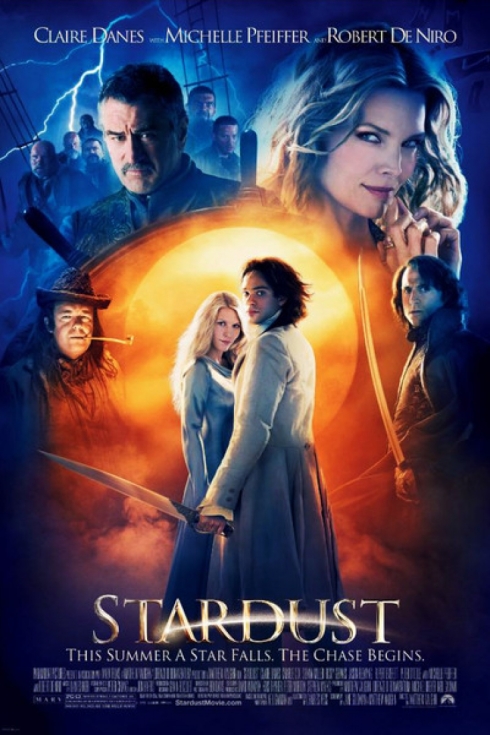Nostra at “Myfilmviews” is continuing his 5-Obstrucitons blogathon, and I have waited to the absolutely last possible minute to post my entry. For this interview review I have asked my husband to be the interviewee, Edwin Scharlau. I first thought about conducting an interview about his documentary, Unfit: Ward vs Ward, but I felt I would be cheating since I had such easy access to the filmmaker. When I asked Edwin which film he would like to be interviewed on he said Stardust. I first I said no since I recently reviewed it here, but after a lackluster Hugo interview I relented. So, without further ado,
VMR: Why Stardust?
ES: Because it is the only movie in my memory that I can recall going back to watch in a theatre a second time the following day.
VMR: What made you want to watch it again?
ES: Everything about that movie was so perfect that I wanted to see it again to validate that feeling from watching it the first time. I’m not normally a fan of fantasy, but something just really spoke to me about that movie. I don’t know if it was the great mix of the time period, or the whole mystical aspect, the visuals, the music. Everything just seemed to come together perfectly for that one.
VMR: What about the music did you like so much?
ES: I liked the epic feel of the music. There was something about the music that made my heart race.
VMR: What were you favorite scene involving the music?
ES: When Michelle Pfeiffer is on the cliff and walks away with the whole landscape in the background.
VMR: You said the movie “spoke to you,” in what way?
ESI think it had a really good message. The way Tristan went out on this adventure to search for something for this girl he had a puppy-dog crush on because she seemed like the perfect girl for her—though we know she is not. But then he goes out on this adventure and he realizes something about true love. You can find true love in the least likely places or people.
VMR: Do you see a little of Tristan in you?
ES: I think Tristan is probably more adventurous than I am, and a bit more of a hopeless romantic. But I did find him relatable. He does tend to see the good in everyone, and I feel I do the same in most cases.
VMR: Even though you think the movie is practically perfect in every way, is there something you would change?
ES: There is nothing I would change about that movie.
I think another reason way I liked it, though it was fantasy, was that it made sense to me. It seemed much more realistic to me then some other movies…like science fiction movies. There is something really human and relatable to it. I also really liked that they took Michelle Pfeiffer–who is arguably one of the most attractive women ever–and turned her into an old ugly witch, and she was wiling to do that. And that they could take Robert de Niro—a badass tough guy—and put him in a dress, and he was willing to do that.
VMR: Have there been any other movies that spoke to you in the same way?
ES: No, not fantasy movies. Thinking about it, Big Fish also spoke to me. It was similar in that there is something real about it, but there is the fantasy element in it. The Narnia films as well. There is something incredibly sweet about Stardust. It had everything in it: greed, honesty, love, beauty.
VMR: Where you surprised to learn this was only the director’s second film?
ES: Yes. It did surprise me he was able to do such a big movie with a big cast.
VMR: Did you enjoy his third film Kick-Ass?
ES: Yeah, I did. It was surprisingly funny.
VMR: Final question. What numerical and alphabetic score do you give Stardust?
ES: A+ and 10
VMR: Thank you.









“Fahrenheit 451” – Book / Play / Film
Fahrenheit 451 is novel written by Ray Bradbury about a dystopian near-future where books are banned, and if discovered burned by “Firemen”. Bradbury himself wrote an adaptation for the stage, and Francois Truffaut & Jean-Louis Richard wrote and adaptation for the screen.
I read Fahrenheit 451 for the first time in September, 2012 while on vacation. I cannot remember the last time a book so affected me and caused me to think. I vaguely remembered a film was made, and while researching the film I discovered that Bradbury also wrote the play. Soon thereafter I bought the play and ordered the film. What follows is my comparison of the three.
The protagonist is Guy Montag, a “Fireman”. His life is changed after meeting and befriending his young neighbor Clarisse. Slowly waking from the apathy of his life, Montag starts to save and read books. He decides the society that he lives in must be challenged and changed.
The near-future of Fahrenheit 451 is a familiar one. More accessible now than when the book was first published and film released. The world presented is one in which everyone is numb and people only care about their immediate pleasures. No one is really connected with each other, even if they are husband & wife. This is represented most clearly through the character of Montag’s wife, Mildred in the book and Linda in the film. She takes pills to sleep, pills to wake, and spends her days in distraction with her “parlor walls” interactive television–where everyone will get their chance at fifteen minutes of fame. Her friends, actually convenient acquaintances, are equally vapid.
Books became banned not through the act of an over reaching government, but through the growing apathy of the citizenry over decades. As the population grew and the pace of life accelerated people wanted their books to be shorter and easy to read. As time went on and the books were abridged and then reduced to bullet points, people wanted only those that made them happy and did not challenge them to think. And still later with the rise of minorities & special interests and the need not to offend becoming prevalent, the people further abandoned and then banned the books.
Compare this future to our present. This is a time of shrinking newspapers and one page internet articles, a time of the two-minute news piece and fluff entertainment interview, a time of hundreds of celebrity articles/posts to one thought-provoking essay. We live in a time of no talent “celebrities” getting their fifteen minutes of fame. A time where the “parlor walls” of Fahrenheit 451 are the smart phones & tablets of today. How many times have you been to dinner and eyed a family across the way where everyone at the table is obsessed not with the conversation between themselves–because there is none–but what they are doing on their smart phone and/or tablet?
The most interesting character is Captain Beatty. The strength of the book and play, and weakness of the film is him. Beatty is a bizarro surrogate for Bradbury. His monologue of how and why books were banned is Bradbury ranting about things to come. It is implied by the book and made explicit in the play that Beatty is not only well read, but also an owner of books. The book leaves you wanting to learn more about him. Bradbury either knew this or wanted to learn more about Beatty himself, because he delivered in spades with the play. On the opposite side, the film reduces the character and the movie surfers for it.
Another key difference between the book and other adaptations is the fate of Clarisse. Bradbury so liked what Truffaut did with the character he emulated it in the play. Also, whereas the book and play have the hound, the film does not–most likely due to the budget and special effects technology at the time.
Experiencing Fahrenheit 451 across three mediums was interesting and proof positive each one must be treated uniquely. The book came first and is a triumph of literature. The film followed and was flawed. And though it was the weakest interpretation of the story, it still had some good take-aways. Having Julie Christie play both Montag’s wife and Clarisse was an inspired choice, and brought into sharp contrast the rot in Montag’s society. The play was last and focused the story to its key components, while at the same time adding new information about the characters.
Book = A
Play = A
Film = C- (you can read my review here)
6 Comments | tags: Ray Bradbury | posted in Comment, Comparison, Posters